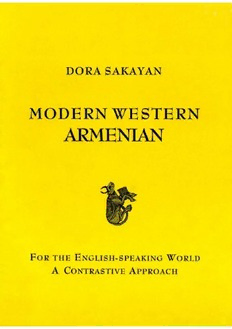
Modern Western Armenian for the English-speaking world: a contrastive approach PDF
388 Pages·2000·25.912 MB·English
Most books are stored in the elastic cloud where traffic is expensive. For this reason, we have a limit on daily download.
Preview Modern Western Armenian for the English-speaking world: a contrastive approach
Description:
MODERN WESTERN ARMENIAN FOR THE ENGLISH-SPEAKING WORLD is an introductory, yet complete first-year course for adults in the English-speaking world. It is a handbook for both the prospective teacher and the student of Armenian. However, the full guidance given in this textbook will allow motivated learners to use it for self-instruction as well. The book incorporates the recent achievements of applied linguistics into the instruction of Western Armenian. Although grammar is treated as an important aspect in mastering the language, other linguistic areas also receive attention. How does Dora Sakayan1s MODERN WESTERN ARMENIAN differ from other manuals of Western Armenian: a. Each unit opens with Dialogues, a short exchange of utterances used in a given situation. The idea is to promote oral skills for recurring situations, i.e. to enable students to interact in Armenian by carrying out fundamental speech acts such as making a request and responding to it, expressing agreement or disagreement, conveying information and reacting to it, seeking an opinion and expressing one, asking for advise and giving it, etc. b. In the first half of the book, all newly introduced Armenian words and texts are accompanied by transliteration. The transliteration system adopted in this book is Latin-based to facilitate both the spelling and the pronunciation of Western Armenian words. This transliteration system takes into account not only graphic correspondences, but also phonetic subtleties of Armenian. c. Although grammar (morphology and syntax) is treated as an important aspect in mastering the language, other linguistic areas also receive attention. Grammar in this book is not a goal in itself, but a means of achieving 3communicative competence.2 d. The book places special emphasis on Armenian-English contrasts and all discussions are based on such an approach. A special section, Armenian-English Contrasts, analyses particular structural differences between the two languages. e. Word Formation, an essential but often overlooked area in language instruction, is given proper treatment. Each unit discusses derivation, composition or inversion patterns that are productive in certain word classes in Armenian. f. Each unit contains a special section, Pronunciation, focusing on particular sounds, word accent, syllabification, etc. g. To acquaint students with Armenian folklore, each unit includes a few Armenian proverbs with their English translation. These proverbs are thematically and structurally related to the main topic of each unit. h. Cross references throughout the book and an index at the end of the appendix bring related linguistic materials together. i. Writing is practiced throughout the first four units in which the 38 letters of the Armenian alphabet are introduced. Letters are presented as calligraphic samples along with their printed and transliterated counterparts. j. Each unit concludes with a good number of Exercises which have one goal: the development of communicative competence.To ensure the crucial shift from traditional third-person sentences which are often isolated and unrelated to 3I-and-you2 interactions, various forms of communicative exercises are introduced. k. Along with the section of Readings, Grammar Tables, and an extended Armenian-English and English-Armenian Glossary with all Armenian entries transliterated, the Appendix contains a collection of Gambits. These are routine formulas or 3pre-fabricated2 parts used in everyday speech that are readily transferable to recurrent life-settings. l. The well-structured typographic layout of this textbook pleases the eye, and clarity in the description of linguistic material makes the learning of Armenian a pleasure.
See more
The list of books you might like
Most books are stored in the elastic cloud where traffic is expensive. For this reason, we have a limit on daily download.
